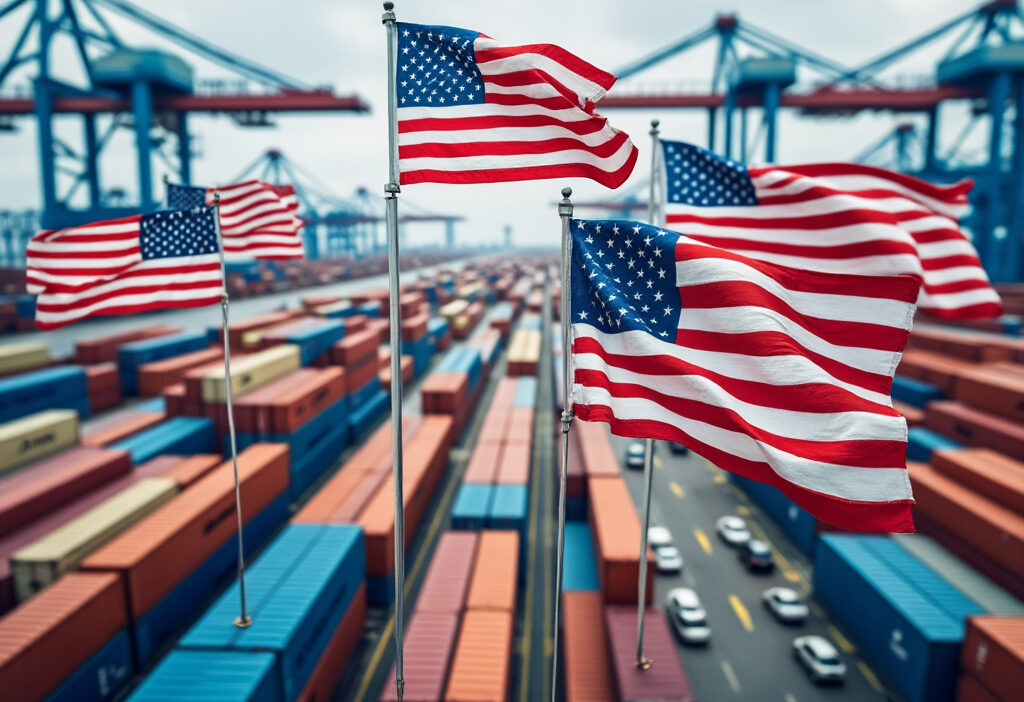Understanding the New Tariffs in the USA
The United States has recently implemented a series of new tariffs, marking a significant shift in trade policy. These measures, aimed at protecting domestic industries and addressing trade imbalances, have sparked widespread debate and international response. This article delves into the specifics of these tariffs, their implications for the global economy, and what they mean for consumers and businesses alike.
The Genesis of Recent US Tariffs
The recent wave of U.S. tariffs stems from a complex interplay of economic protectionism and geopolitical strategy. While past administrations, like Trump’s, leaned heavily on tariffs as a tool to rebalance trade deficits—particularly with China—the current policies reflect a more nuanced approach. Biden’s administration has retained some of these measures but reframed them under broader objectives, such as strengthening domestic industries and countering China’s economic influence.
Political motivations are equally pivotal. Tariffs now serve as leverage in negotiations, addressing concerns like intellectual property theft and unfair subsidies. The CHIPS and Science Act and Inflation Reduction Act further underscore this shift, tying trade policy to national security and green energy goals.
Economically, tariffs aim to revive manufacturing, but critics argue they risk inflation and retaliatory measures. The evolution from Trump’s blunt tariffs to Biden’s targeted ones highlights a strategic pivot—prioritizing long-term resilience over short-term gains. This sets the stage for the next chapter, which delves into the specifics of these tariffs and their global repercussions.
Key Tariffs and Their Targets
The Biden administration has recently introduced a series of tariffs targeting specific industries and trading partners, with a focus on strategic sectors like clean energy, semiconductors, and steel. Among the most significant are tariffs on Chinese electric vehicles (EVs), which now face a 100% duty, effectively blocking their entry into the US market. Additionally, solar cell imports from China are subject to a 50% tariff, while lithium-ion batteries face a 25% levy. These measures aim to protect domestic green energy industries from foreign competition.
Steel and aluminum tariffs have also been expanded, with rates of 25% and 10%, respectively, primarily affecting imports from China, Russia, and some European nations. However, exemptions exist for allies like Canada and Mexico under the USMCA framework. Another notable exception applies to certain medical equipment, which remains tariff-free to avoid supply chain disruptions.
Semiconductors, a critical sector, now see a 50% tariff on Chinese-made chips, reinforcing efforts to reshore production. Meanwhile, legacy semiconductors from China face a 25% duty, though some exemptions apply for low-volume imports. These tariffs reflect a targeted approach, balancing economic protectionism with strategic supply chain resilience.
Impact on Domestic Industries
The new tariffs introduced by the USA have created a mixed impact on domestic industries, with some sectors gaining a competitive edge while others struggle with increased costs. Steel and aluminum producers are among the biggest beneficiaries, as higher import tariffs on these materials have boosted demand for domestically produced goods. Companies like Nucor and U.S. Steel have seen revenue growth, leveraging protectionist policies to expand market share. Similarly, solar panel manufacturers have gained from tariffs on Chinese imports, fostering local production.
However, industries reliant on imported raw materials face significant challenges. Automakers, for instance, grapple with higher steel and aluminum costs, squeezing profit margins. The consumer electronics sector also suffers, as tariffs on Chinese components raise production expenses, potentially leading to higher retail prices. Small and medium-sized businesses, lacking the scale to absorb these costs, are particularly vulnerable.
The agricultural sector presents a complex case. While some farmers benefit from reduced foreign competition, others face retaliatory tariffs from key export markets, hurting sales of soybeans, pork, and dairy. This uneven impact underscores the delicate balance between protecting domestic industries and maintaining global trade relationships, setting the stage for potential disputes outlined in the next chapter.
Global Reactions and Countermeasures
The new U.S. tariffs have triggered swift and varied reactions from trading partners worldwide, with many nations adopting retaliatory measures to protect their own economies. China, the primary target of the tariffs, has responded by imposing duties on key U.S. exports like agricultural products, automobiles, and chemicals, directly impacting American farmers and manufacturers. The European Union, meanwhile, has threatened targeted tariffs on politically sensitive U.S. goods, including bourbon and motorcycles, aiming to pressure Washington into negotiations.
Ongoing disputes at the World Trade Organization (WTO) highlight the legal challenges to these tariffs, with several countries arguing they violate international trade rules. Countries like Canada and Mexico, though exempt from some tariffs due to renegotiated trade agreements, remain wary of future U.S. policy shifts.
In response, some nations are diversifying supply chains to reduce reliance on U.S. markets, while others are forming new trade alliances to counterbalance American influence. For instance, the Comprehensive and Progressive Agreement for Trans-Pacific Partnership (CPTPP) has gained momentum as an alternative to U.S.-led trade frameworks. These countermeasures underscore the growing fragmentation in global trade, with long-term implications for U.S. economic leverage. Negotiations remain tense, with little consensus on resolving the escalating trade tensions.
Economic Implications for the USA
The new tariffs imposed by the USA are reshaping the domestic economic landscape, with significant implications for inflation, employment, and GDP growth. Higher import costs are driving up prices for businesses reliant on foreign materials, contributing to inflationary pressures. Industries like automotive and electronics, which depend heavily on global supply chains, face increased production costs, often passed on to consumers. This ripple effect could dampen consumer spending, a key driver of US economic growth.
On the employment front, tariffs may both protect and disrupt jobs. While they aim to shield domestic industries from foreign competition, retaliatory measures from trading partners—as discussed in the previous chapter—could hurt export-dependent sectors like agriculture and manufacturing. The net effect on employment remains uncertain, with potential job gains in protected industries offset by losses in others.
GDP growth could also face headwinds. Trade restrictions typically reduce economic efficiency, leading to slower productivity gains. Additionally, heightened trade uncertainty may discourage business investment, further stifling expansion. While tariffs may offer short-term protection for certain sectors, their long-term economic impact could be more contractionary than anticipated, setting the stage for the consumer consequences explored next.
Consumer Consequences
The new tariffs imposed by the USA have a direct and often immediate impact on consumers, reshaping purchasing power and market dynamics. By increasing the cost of imported goods, these tariffs often lead to higher retail prices, particularly for everyday items like electronics, clothing, and household goods. For example, tariffs on Chinese-made consumer electronics, such as smartphones and laptops, have forced manufacturers to raise prices, passing the added costs onto buyers. Similarly, duties on steel and aluminum have increased the prices of appliances, cars, and construction materials.
Beyond price hikes, tariffs can also disrupt product availability. Some retailers, facing higher import costs, reduce inventory or shift to lower-quality alternatives. For instance, furniture retailers relying on Chinese imports have reported delays and limited selections due to tariff-related supply chain adjustments. Meanwhile, domestic producers benefiting from reduced competition may not always fill the gap, leading to shortages in certain sectors.
Low- and middle-income households bear the brunt of these changes, as they spend a larger share of their income on affected goods. While the previous chapter highlighted macroeconomic effects like inflation, this consumer-level impact underscores how trade policies translate into tangible financial strain for everyday Americans. The next chapter will examine whether these measures actually address trade deficits as intended.
Trade Deficits and Tariffs
The new tariffs imposed by the USA aim to address persistent trade deficits by making imports more expensive and encouraging domestic production. However, the effectiveness of tariffs in reducing trade deficits remains debated. While tariffs can theoretically lower imports by increasing costs for foreign goods, they often fail to account for complex global supply chains and consumer demand elasticity. For example, tariffs on Chinese steel may reduce imports in that sector, but they could also raise costs for US manufacturers relying on those materials, indirectly affecting exports.
Data from recent years shows mixed results. The US trade deficit with China narrowed slightly after tariffs were imposed in 2018, but the overall deficit with the world continued to grow, reaching record highs in 2022. This suggests that tariffs alone may not rebalance trade, as production often shifts to other low-cost countries rather than returning to the US. Additionally, retaliatory tariffs from trading partners have hurt US agricultural exports, further complicating the deficit picture.
Economists argue that trade deficits are influenced by macroeconomic factors like savings rates and currency values, not just tariffs. Without broader fiscal or industrial policies, tariffs risk becoming a blunt instrument with unintended consequences, as explored in the next chapter regarding WTO disputes.
Legal and WTO Considerations
The new U.S. tariffs have sparked legal scrutiny under both domestic and international frameworks. Domestically, the Trade Expansion Act of 1962 and Section 301 of the Trade Act of 1974 provide the legal basis for these measures, allowing the president to impose tariffs for national security or unfair trade practices. However, critics argue these laws are being stretched beyond their original intent, leading to potential court challenges.
At the WTO, the U.S. faces mounting disputes from trading partners alleging violations of Most-Favored-Nation (MFN) principles and bound tariff rates. Precedents like the US – Steel and Aluminum Tariffs (DS544, DS556) cases show the WTO often rules against unilateral tariffs unless justified under Article XXI (national security exceptions). Yet, the U.S. has historically disregarded unfavorable WTO rulings, undermining the organization’s authority.
Potential outcomes include retaliatory tariffs or negotiated settlements, but the WTO’s weakened dispute resolution system—due to blocked appellate body appointments—limits enforcement. This legal uncertainty could accelerate fragmentation in global trade rules, pushing nations toward bilateral agreements outside the WTO. The interplay between domestic law and international commitments will shape not only tariff legitimacy but also the future of multilateral trade governance.
Future of US Trade Policy
The future of US trade policy remains uncertain, shaped by domestic politics and global economic dynamics. With the 2024 election looming, a potential shift in administration could reverse or reinforce current tariff strategies. If the incumbent retains power, expect a continuation of protectionist measures, particularly targeting sectors like clean energy and semiconductors to bolster domestic production. Conversely, a new administration might prioritize multilateral agreements, easing tensions with allies while maintaining pressure on strategic rivals like China.
Global economic shifts, such as supply chain diversification and the rise of regional trade blocs, will also influence US policy. The push for nearshoring and friendshoring could lead to preferential tariffs for countries aligned with US interests, reducing reliance on adversarial markets. Meanwhile, climate policies may introduce carbon border adjustments, penalizing imports from high-emission economies.
Technological competition will further drive trade decisions, with export controls and tariffs on advanced tech likely expanding. The WTO’s weakening authority, as discussed earlier, means the US may increasingly bypass multilateral frameworks, opting for bilateral or sector-specific deals. Businesses must prepare for volatility, as the interplay of politics and economics keeps the trade landscape in flux.
Navigating the New Trade Landscape
The new tariff landscape in the USA presents both challenges and opportunities for businesses and consumers. To mitigate costs, businesses should consider diversifying supply chains, sourcing from countries not heavily impacted by tariffs, or negotiating long-term contracts with suppliers to lock in prices. For manufacturers, localizing production or shifting to tariff-exempt components can reduce expenses. Consumers may need to adjust purchasing habits, opting for domestic alternatives or waiting for seasonal discounts on affected imports.
Strategies to leverage opportunities:
- Explore tariff exclusions: Some products qualify for exemptions; businesses should actively monitor and apply for these.
- Invest in automation: Reducing labor costs can offset tariff-related price increases.
- Reprice strategically: Adjust pricing models to absorb some costs while remaining competitive.
- Monitor policy shifts: Staying ahead of potential tariff adjustments allows for agile decision-making.
For both businesses and consumers, staying informed is critical. Subscribing to trade policy updates and consulting experts can help navigate uncertainties. While tariffs may strain margins, proactive adaptation can turn disruptions into competitive advantages.
Conclusions
The new tariffs in the USA represent a pivotal moment in trade policy, with far-reaching effects on domestic and global economies. While aimed at protecting US interests, their implementation has sparked complex challenges and reactions. As the situation evolves, staying informed and adaptable will be key for all stakeholders involved.



